The Life of Saint Catherine of Sienna
Today, the Church celebrates the memorial of one of the few women who have been declared a "Doctor of the Church" - Saint Catherine of Sienna. She's probably most remembered for having deliberately told popes, queens and kings how to behave. We was spontaneous, unafraid of authority, fearless in the face of death BUT loved the Church and the Holy Father, the Pope, and lived her life in total obedience to him - while at the same time urging him to return to Rome.
 Born in 1347, at Siena, Italy, Saint Catherine lived through the Black Death, famine and numerous civil wars. During her lifetime the papal residence moved from Rome to Avignon and back again, and the great western Schism pitted Pope against anti-pope. Even at a young age, Catherine sensed the troubled society around her and wanted to help. Childishly she dreamed of dressing up like a man to become a Dominican friar; more than once she ran into the street to kiss the ground where Dominicans walked.
Born in 1347, at Siena, Italy, Saint Catherine lived through the Black Death, famine and numerous civil wars. During her lifetime the papal residence moved from Rome to Avignon and back again, and the great western Schism pitted Pope against anti-pope. Even at a young age, Catherine sensed the troubled society around her and wanted to help. Childishly she dreamed of dressing up like a man to become a Dominican friar; more than once she ran into the street to kiss the ground where Dominicans walked.Catherine's parents tried hard to discourage her from becoming religious, but eventually, when she was about sixteen-years-old, Catherine, with the help of the Holy Spirit, was permitted to enter the sisters of Penance of St Dominic. During her life as a religious, St. Catherine had numerous visions and long ecstasies, but she is most remembered for her writings, which eventually led to her being declared a Doctor of the Church by Pope Paul VI in 1970.
Her bold letters, even today, have a way of shocking the reader into reality. The style of her letters was lean and direct. She sometimes broke with polite convention. For example, during the Great Western Schism, in defense of Pope Urban VI, she rebuked three Italian cardinals who were supporting the anti-pope, writing to them, "what made you do this? You are flowers who shed no perfume, but stench that makes the whole world reek."
These words are strong, and it is not recommended that we imitate them. St. Catherine had a unique call from God, which Pope Paul VI referred to as her "charism of exhortation." It was her great love and fidelity to the Pope and college of bishops that prompted her to respond to God's urgings that she be forthright with those who were against the Vicar of Christ.
Wanting Pope Gregory XI to leave his residency in Avignon and return to Rome, and knowing the Supreme Pontiff was afraid of being poisoned, Catherine wrote to him, "Be not a timorous child, but manly . . ." she spoke to him as a loving daughter would.
 It was with great courage that Catherine approached the Vicar of Christ. She succeeded in convincing Pope Gregory XI to return to Rome, but he soon died and Pope Urban VI took his place. Relentless, Catherine began to write to the new Pope. She was direct with him and told him he needed to control his temper. Pope Urban VI appreciated her forthright counsel. When an anti-pope was supported and the Great Western Schism began, Urban VI invited Catherine to Rome. He needed her support. She went to Rome in 1378 and from there wrote regular letters to state and Church leaders in defense of Pope Urban's sole right to the papal throne. Every day she walked to St. Peter's Basilica and prayed for church unity. After two years of this exhaustive work, she died in 1380 at age thirty-three.
It was with great courage that Catherine approached the Vicar of Christ. She succeeded in convincing Pope Gregory XI to return to Rome, but he soon died and Pope Urban VI took his place. Relentless, Catherine began to write to the new Pope. She was direct with him and told him he needed to control his temper. Pope Urban VI appreciated her forthright counsel. When an anti-pope was supported and the Great Western Schism began, Urban VI invited Catherine to Rome. He needed her support. She went to Rome in 1378 and from there wrote regular letters to state and Church leaders in defense of Pope Urban's sole right to the papal throne. Every day she walked to St. Peter's Basilica and prayed for church unity. After two years of this exhaustive work, she died in 1380 at age thirty-three.We need people like St. Catherine of Sienna today!
With the current "crisis" in the Church, we need people like Saint Catherine to stand up for the Truth - to boldly defend the helpless and the victims, but to do so with her love for the Church and the Holy Father. This is something we are not seeing today.
The last thing I want to become is an apologist for the Church in regard to the present abuse crisis. Many people have been seriously harmed by these scandals. I have been disheartened (if that is a strong enough word). I believe, if it had not been so in the past, that members of the Church, including leadership, understand more and are much more sensitive to victims of abuse. We all reverence their struggle.
On the other hand, I am more and more disturbed and unsettled by groups who are using victims of child sex abuse to promote their own self-serving agenda. It is inexcusable!
Specifically, I am referring to those who would disassemble an ancient Church and reassemble her to fit norms and preferences acceptable to their own closed and limited whims. Some, today, are using the failings of clergy in order to promote the feminist agenda within the Church. Their approach to "reprimanding" Church leadership is not what Saint Catherine did. She loved the Church and the Pope - the current "critics" want to destroy the Church and the Papacy - make no doubt about it.
This is not easy to say, probably less easy to read, but if the Catholic Church began ordaining women to the priesthood today, there would not be a single additional article published about sexual abuse cases. The victims of abuse deserve to be heard, but the liberal culture could care less… they are only using this misfortune to promote a self-serving agenda. For years, I truly believed the “culture” hated the Church because of her stand on abortion, same-sex marriage, contraception, or divorce. But now, it is ever more clear, more than just these issues; the real issue is the male priesthood.
Remember, I believe we deserve the beating we are receiving. The actions taken or not taken by bishops in certain cases in regard to failures of the clergy is indefensible.
To illustrate, consider an article by an allegedly Catholic woman, Maureen Dowd, in her New York Times Op-Ed Column she entitled: A Nope for Pope.
She begins her silly piece, “Yup, we need a Nope. A nun who is pope.” Then spills paragraph after paragraph of distorted and inaccurate reports of what the Church did or did not do to address the current abuse situation. [Remember, if you are an advocate for victims of sex abuse, this is terribly hurtful to the cause as the truth of the situation is not being told. Many will dismiss the true problems in the Church and consider them part of the hype created by people like Ms. Dowd.]
She concludes her article with “The nuns have historically cleaned up the messes of priests. And this is a historic mess. Benedict should go home to Bavaria. And the cardinals should send the white smoke up the chimney, proclaiming ‘Habemus Mama.’” Thus, she uses the current painful situation for her own power-seeking agenda. For example, “Nuns have historically cleaned up the messes of priests?” Really? How about just one example?
Next, another Catholic women, Peggy Noonan, has played the same card in the April 17th Wall Street Journal. After drudging up dirt on the Church which would make the Boston Globe jealous, she concludes “The old Vatican needs new blood… Most especially and most immediately, they need to elevate women. As a nun said to me [Ms. Noonan] this week, if a woman had been sitting beside a bishop transferring a priest with a history of abuse, she would have said, ‘Hey, wait a minute!’”
First, there were plenty of men in the priesthood or hierarchy who did say, “Hey, wait a minute!” It is ludicrous for an educated woman like Noonan to think otherwise. That the Church would be better off if we simply elevated women is a myth. Women sin just as men sin. Furthermore, from personal experience, my brother priests and I could provide ample examples of women [i.e., theologically liberal nuns] who were on staff in our seminaries and who intervened to protect dysfunctional men allowing them to advance to the priesthood. We seminarians protested, but were "silenced" by Sr. "Mary" while the dysfunctional men were advanced to Holy Orders. And again, how many women (mothers) have stood by while their husbands or boyfriends molested their own children without intervening? Answer: it happens… too frequently.
I, too, like John Paul II, believe that women contribute greatly to the life of the Church, and should be given more opportunity to do so… but it will be on their own merit, not in the sleazy way Dowd and Noonan and their ilk are attempting to do it. Rather, we need more women like St. Catherine of Sienna - women who are not afraid to speak the Truth - even to the hierarchy, but who do it with love for the Church and as loving daughters of the Pope.
Before I close, I want to illustrate how the press is distorting the truth to confuse Catholics. Ms. Dowd reports that the Associated Press broke a story “pointing the finger of blame directly at Cardinal Joseph Ratzinger.” The AP concluded that a newly discovered letter exists “in which [Cardinal Ratzinger is shown] to resist pleas to defrock a California priest who had sexually molested children.” The report claims “the Oakland diocese recommended defrocking Father Stephen Kiesle in 1981.” The priest had pleaded no contest and was sentenced to three years’ probation in 1978 for “tying up and molesting two boys in a church rectory.”
Two things to keep in mind about this article:
1) Dowd claims that it “wasn’t until 1985 that “God’s Rottweiler” finally got around to addressing the California bishop’s concern (and defrocked the priest). The manner in which the information is presented, makes it seem as though this sick man was allowed to molest children from 1978 to 1985. What is not reported, however, is that the Oakland Bishop had absolute authority (and I am confident he used it) to remove the faculties (permission necessary to function in a priestly role) of the priest, effectively barring him from the priesthood prior to 1978. Not reported.
2) Much has been made about Ratzinger’s concern about “scandal.” Really? Look at the dates. The press had its day and its opportunity to report the scandal in 1978 when the priest was publically convicted. There was no fear of scandal as it has already been reported. The scandal Cardinal Ratzinger was concerned about is a canonical question considered for any priest waiting to be laicized by the Church: “Will it cause scandal or hurt people’s faith to see a man leave the priesthood?” Obviously, the answer in this case was no.
History will look with melancholy upon the last 50 years of the Church. But I sincerely hope the truth is separated from the lies. Has anybody else noticed that a week after the U.S. Bishops condemned Obama's new Health Care Law, the New York Times splashed articles on the front page of their paper detailing sexual abuse cases against the Church in which nothing new was reported? In other words, “You stupid and superstitious Catholics, shut up!”
In the end, it is safe to conclude that these people hate the Church far more than they love the victims.













